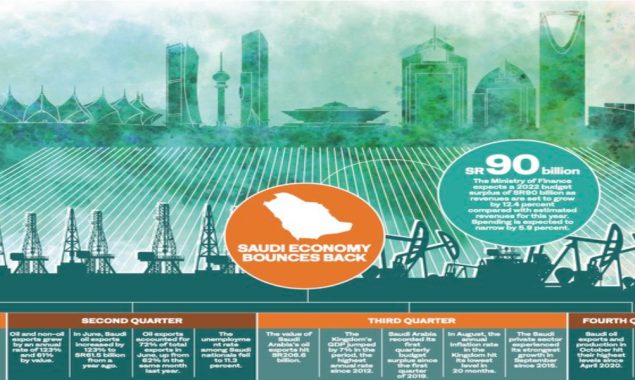Saudi economy expands in third quarter at highest rate since 2012
CAIRO: The Saudi economy expanded by an annual rate of 7 per...

Image: Arab News
RIYADH: The Saudi economy recovered in 2021 after a tough year of pandemic restrictions as vaccination campaigns rolled out in the kingdom and across the world driving its key oil exports, Arab News reported.
MENA’s largest economy bounced back from last year, when the kingdom’s gross domestic product contracted by 4.1 per cent, according to the International Monetary Fund.
But this year saw higher oil output, its first quarterly budget surplus in over two years and lower unemployment drove growth.
Some economic data in 2021 even bettered pre-pandemic levels, although the full effect of the latest omicron variant is yet to be played out.
Here are the kingdom’s economic key highlights this year:
First quarter: Oil exports lift
The value of oil exports continued its rebound in the first quarter of 2021, rising for the third consecutive quarter and hitting the highest level since the final quarter of 2019, according to official data.
However, in all four quarters of 2021, the kingdom’s oil exports were lower when compared to the corresponding periods in 2019.
Second quarter: Unemployment eases
Oil and non-oil exports grew by an annual rate of 123 per cent and 61 per cent in the second quarter by value, respectively, according to the General Authority for Statistics. These were the highest annual growth rates for both categories since at least 2018.
In June, the value of Saudi Arabia’s oil exports increased by 123 per cent to SR61.5 billion ($16.4 billion) from a year ago, said GASTAT.
Oil exports accounted for 72 per cent of total exports in June, up from 62 per cent in the same month last year, it added.
HIGHLIGHTS
MENA’s largest economy bounced back from last year, when the kingdom’s gross domestic product contracted by 4.1 per cent, according to the International Monetary Fund.
This year saw higher oil output, its first quarterly budget surplus in over two years and lower unemployment drove growth.
Some economic data in 2021 even bettered pre-pandemic levels, although the full effect of the latest omicron variant is yet to be played out.
The unemployment rate among Saudi nationals fell to 11.3 per cent in the second quarter, the lowest since at least the same period in 2016, said GASTAT, attributed to ongoing government efforts to boost local employment in the private sector.
By contrast, Saudi unemployment had hovered at a mean rate of 13.7 per cent in 2020.
The third quarter: Budget surplus and falling inflation
The value of oil exports hit SR206.6 billion in the third quarter, the highest since the final quarter of 2018, as the sector enjoyed rising demand and higher prices.
This led the kingdom’s GDP to jump by 7 per cent in the period, the highest annual rate since 2012. Oil and non-oil output surged by 9.3 per cent and 6.3 per cent, respectively.
The Ministry of Finance added that the kingdom recorded its first quarterly budget surplus since the first quarter of 2019. The surplus was valued at SR6.7 billion, reversing a SR4.6 billion deficit in the previous quarter.
The upswing was driven by multiyear high crude prices and government social spending cuts, as the pandemic eased.
In August, the annual inflation rate in the kingdom hit its lowest level in 20 months, reaching 0.3 per cent. Rises in consumer prices in the second half of the year slowed as the effects of the VAT hike from 5 per cent to 15 per cent in July 2020 faded.
The inflation rate in June 2021 had been 6.2 per cent, which tumbled to 0.4 per cent in July.
The Saudi private sector experienced its strongest growth in September since 2015, according to IHS Markit, driven by new orders and higher output. Shoppers received a boost following the easing of lockdown restrictions, driving growth.
Back in 2020, Saudi Arabia’s annual inflation rate averaged 3.4 per cent, driven by the VAT rise.
Also, the budget deficit hit SR293.9 billion in 2020, rising more than two-fold compared to 2019. Spending on social benefits, subsidies and grants were all raised, at the height of the pandemic.
The fourth quarter: More oil production
Saudi oil exports and production in October hit their highest levels since April 2020, according to data published by Jodi. Oil shipments lifted 5 per cent in the previous month to 6.83 million barrels per day. Fuel production rose to 9.78 million bpd, only slightly higher than in September, but this was 9 per cent up on a year ago.
Forecasts for 2022
The outlook for the Saudi economy next year is favorable, according to government and economic forecasters.
The Ministry of Finance expects a 2022 budget surplus of SR90 billion as revenues are set to grow by 12.4 per cent compared with estimated revenues for this year. Spending is expected to narrow by 5.9 per cent. This will give the kingdom its first fiscal surplus since 2013, if achieved.
The ministry forecasts that the economy will grow by 7.4 per cent next year.
Capital Economics has a similar forecast of 7.3 per cent, saying that oil production will push up the kingdom’s output in 2022.
The GCC Statistical Centre, Jadwa Investment as well as Capital Economics expect Saudi Arabian inflation in 2022 to settle at between 1 and 2 per cent as last year’s VAT rise continues to ease.
Catch all the Business News, Breaking News Event and Latest News Updates on The BOL News
Download The BOL News App to get the Daily News Update & Follow us on Google News.